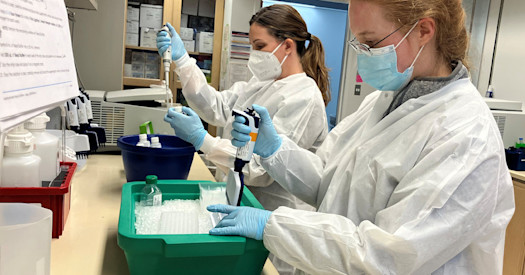 Seattle Hub’s Sense Team: Clockwise from left – Ruby Padgett, Reuben Burch, Alessandro Venega Coradini, Soh Ishiguro, Diana Vedenova, and Team Lead Hina Iftikhar.
Seattle Hub’s Sense Team: Clockwise from left – Ruby Padgett, Reuben Burch, Alessandro Venega Coradini, Soh Ishiguro, Diana Vedenova, and Team Lead Hina Iftikhar.
[EDITOR’S NOTE: This is the first in a series of articles on the four teams that comprise the Seattle Hub for Synthetic Biology.]
“It’s exciting to be working on something scientifically deep, but also open-ended enough we could build a lot of new things.” Hina Iftikhar
For Hina Iftikhar, building “a lot of new things” as the Sense Team Lead of the Seattle Hub for Synthetic Biology (Seattle Hub), may be the biggest challenge and greatest opportunity of her scientific career. She and her five colleagues who comprise the team play a foundational role in the Seattle Hub’s objective: creating new technologies to record the history of cells over time.
The project, which launched in January of 2024 with a five-year, $70 million grant, is a collaboration among the Allen Institute, BBI, the UW, and the Chan Zuckerberg Initiative.
In addition to the Sense Team, the Seattle Hub’s work is divided among three other groups:
-
Write Team – Taking data from the Sense Team and creating permanent records (DNA Tapes) in the cellular DNA, which are stored in sequential order, thereby enabling scientists to understand the relative timing of different cellular events.
-
Read Team – Developing computational pipelines and methods to analyze sequencing data and to characterize lineage relationships and biological signaling between cells across various tissues.
-
In Vivo Team – Creating mouse models incorporating the technologies developed by the Sense, and Write Teams to record cellular events in genomic DNA during an organism’s development and growth.
Iftikhar and her Sense Team colleagues are building cellular technologies to record and capture live data from millions of cells as those cells change and respond to their environments within an organism. Currently, that organism is a mouse.
'This future cannot come fast enough.' Seattle Hub's Jesse Gray
But everyone associated with Seattle Hub is looking to the future, including Jesse Gray, Ph.D., the Executive Director for Seattle Hub’s Strategy and Platform.
“We believe science should be fun, and we’re loving our mission to create, refine, and perfect systems that will someday spawn diagnostic or clinical tools to identify and treat diseases in real time,” Gray said. “We are realizing a revolution in programming biology that has incredible potential to eventually address unmet a wide array of medical needs. This future cannot come fast enough.”
In accomplishing that “revolution,” Iftikhar noted the two most significant goals for the “recorder mice” with which the SeaHub Team is working:
-
The first is understanding how cells in an organism are related and tracing each cell’s lineage or family tree, and
-
Identifying how cells make decisions and installing that “sensing capability” into each cell.
“That’s the big gap the Sense Team is bridging,” she said, regarding cells’ decision-making and installing that capability.
How do she and her team members determine a cell’s decision-making capability? How do those decisions turn into barcodes?
“We select different inputs from the cells,” she said. “Say there’s a certain pathway that we expect will be triggered or activated in the cell. We know what kind of RNA and protein gets made.”
They study the RNA and protein created when those cells’ pathways are activated. Sense Team members take these modalities and initiates what Iftikhar calls “a prime editing event.”
“And we mostly do this by a activating a prime editing guide RNA, in response to these events,” she said.
Last January, when she joined Seattle Hub, she inherited some foundational sending work from the lab of Lead Scientific Director Dr. Jay Shendure, M.D, Ph.D., who also serves as BBI’s Scientific Director. The Sense Team is building on that work and finding new ways to identify more modalities as inputs .
“Our team is figuring out the relevant input and how to ensure each cell interacts and ‘records’ with the DNA typewriter, or the prime editing machinery,” she said. “And that process will result in the incorporation of a unique barcode.”
Equally exciting as the science, Iftikhar said, is the collaboration of among the four teams, as well as others working on this endeavor.
“The collaboration and cooperation are quite wonderful,” she said. “We all are committed to helping each other to achieve Seattle Hub’s goals.”

